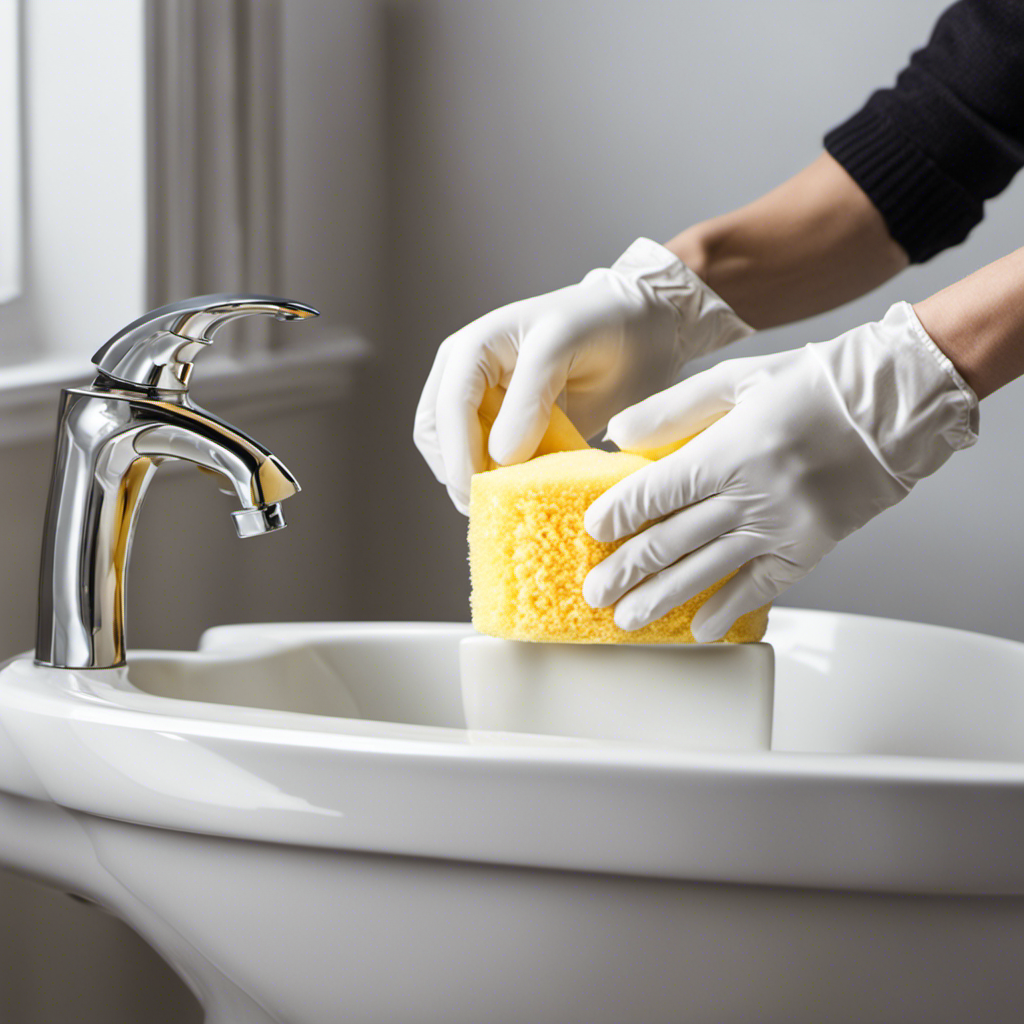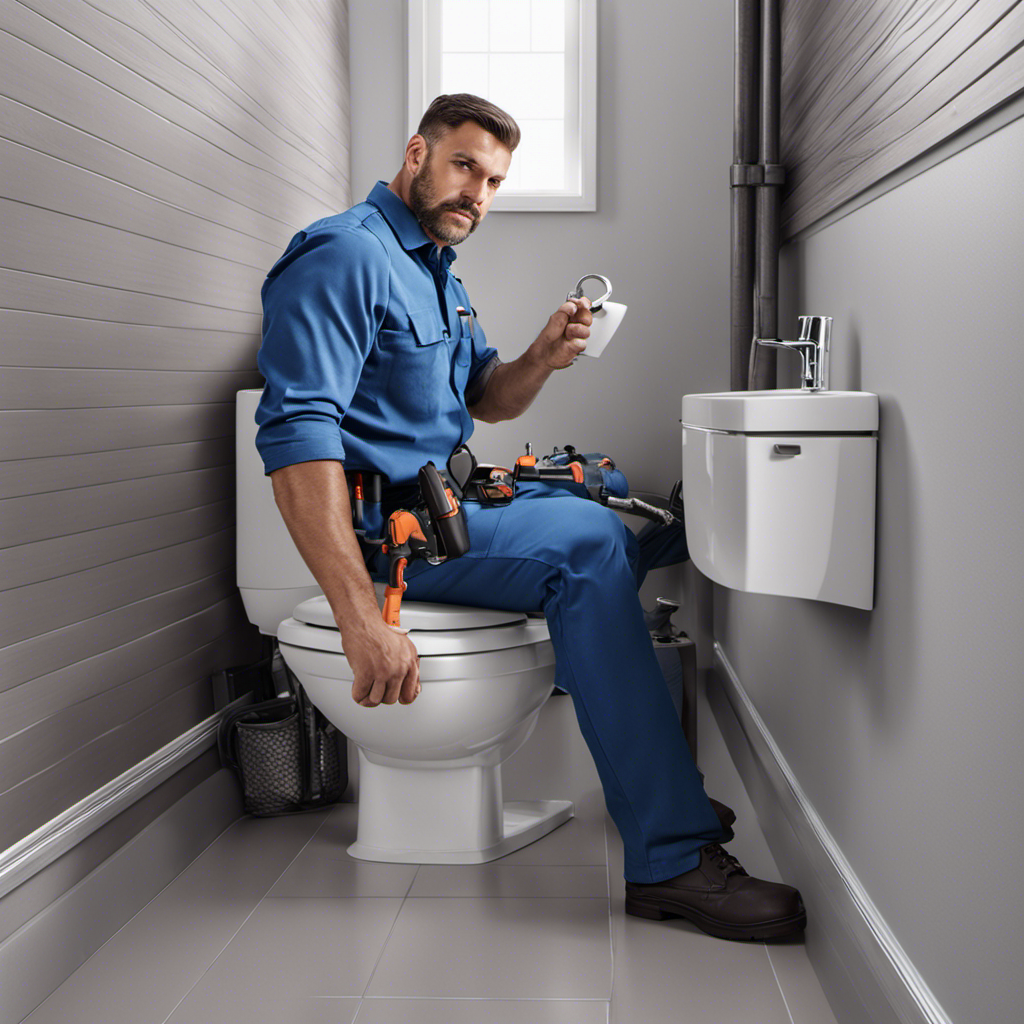Did you know that a leaking toilet can waste up to 200 gallons of water per day?
As a homeowner, it’s essential to know how to fix this common plumbing issue.
In this article, I will guide you through the step-by-step process of identifying the source of the leak, the tools and materials you’ll need, and troubleshooting tips to fix your leaking toilet.
By following these instructions, you can save water, money, and prevent further damage to your bathroom.
Key Takeaways
- Check the base of the toilet for signs of water damage, such as wetness, discoloration, or a musty smell.
- Inspect the water supply line connections for dripping or pooling water.
- Seek professional help if unable to locate the source of the leak, as a plumber can diagnose and fix the issue efficiently and effectively.
- Use tools such as an adjustable wrench, pliers, toilet repair kit, and plumbers tape for the repair.
Identifying the Source of the Leak
First, you’ll want to check if the leak is coming from the base of the toilet or from the water supply line.
To do this, start by inspecting the area around the base of the toilet. Look for any signs of water damage, such as wetness, discoloration, or a musty smell.
If you don’t see any visible signs, it’s time to move on to the water supply line. Check the connections at both ends of the line for any dripping or pooling water.
If you’re unsure or unable to locate the source of the leak, it may be best to seek professional help. A plumber will have the expertise and tools to diagnose and fix the issue efficiently and effectively, ensuring a lasting solution to your leaking toilet problem.
Tools and Materials Needed for the Repair
To begin, grab a wrench and a pair of pliers for the repair. Repairing a leaking toilet can be a simple task that can save you money and prevent further damage. With the right tools and materials, you can fix the problem yourself without the need for professional assistance.
Here are the essential tools and materials you will need to successfully repair a leaking toilet:
-
Adjustable wrench: This tool will help you loosen and tighten nuts and bolts.
-
Pliers: Essential for gripping and turning tight connections.
-
Toilet repair kit: This kit typically includes a fill valve, flapper, flush valve, and other necessary components for repairing common toilet leaks.
-
Plumbers tape: Used to create a tight seal between threaded connections.
Step-by-Step Guide to Fixing a Leaking Toilet
Now that you have all the necessary tools and materials, let’s dive into the step-by-step guide for repairing your leaking toilet. Follow these instructions carefully to ensure a successful DIY plumbing project.
First, turn off the water supply to the toilet by locating the shut-off valve near the base. Next, empty the tank by flushing the toilet and removing any remaining water with a sponge or towel. Now, let’s take a look at the table below, which outlines the steps for fixing a leaking toilet.
| Step | Description |
|---|---|
| 1 | Identify the source of the leak |
| 2 | Tighten or replace the flapper valve |
| 3 | Check and adjust the float |
| 4 | Inspect and replace the fill valve |
Common Problems and Troubleshooting Tips
If you’re experiencing recurring issues with your toilet, it may be helpful to consider some common problems and troubleshooting tips. Here are four signs of a leaking toilet and their possible causes:
-
Constantly running water: This could be due to a faulty flapper valve or a worn-out fill valve. Check these components and replace if necessary.
-
Pooling water around the base: This indicates a wax ring seal failure. Remove the toilet, replace the wax ring, and reinstall the toilet securely.
-
Drips from the tank: A cracked tank or loose connections between the tank and bowl can cause water to leak. Inspect these areas and tighten or replace any faulty parts.
-
Water stains on the ceiling or walls below the bathroom: This suggests a leak from the toilet supply line or the tank-to-bowl gasket. Inspect these areas and repair or replace any damaged components.
Preventing Future Leaks: Maintenance and Tips
Regular maintenance and following these tips can help prevent future leaks in your toilet. It is important to take preventive measures to avoid costly repairs and water wastage.
First, regularly check the water supply line for any signs of leaks or damage. Replace it if necessary.
Second, inspect the flush valve and flapper to ensure they are functioning properly. Clean or replace them if needed.
Third, check the fill valve and adjust the water level to prevent overflow. Additionally, make sure to tighten any loose connections, such as bolts and nuts.
Finally, avoid flushing anything other than toilet paper to prevent clogs and potential leaks.
Frequently Asked Questions
How Much Will It Cost to Fix a Leaking Toilet?
Toilet repair cost depends on the extent of the leak and the required materials. A DIY toilet leak fix can be affordable, but hiring a professional plumber may be necessary for complex issues.
Can I Use Any Type of Sealant to Fix a Leaking Toilet?
You can’t use any type of sealant to fix a leaking toilet. It’s important to use a toilet sealant specifically designed for plumbing repairs. This ensures a proper and long-lasting fix.
Are There Any Health Risks Associated With a Leaking Toilet?
There could potentially be health risks associated with a leaking toilet, such as the growth of mold and water contamination. It’s important to address these issues promptly to maintain a safe and sanitary environment.
Can a Leaking Toilet Cause Damage to the Bathroom Floor?
Yes, a leaking toilet can cause water damage to the bathroom floor. To prevent this, regular maintenance is crucial. Check for leaks, replace faulty parts, and ensure proper sealing.
Is It Necessary to Hire a Professional Plumber to Fix a Leaking Toilet?
It depends on the severity of the leak. Sometimes, hiring a professional plumber is necessary to ensure the problem is fixed correctly. However, for minor leaks, DIY toilet repairs can be a cost-effective option.
Conclusion
In conclusion, fixing a leaking toilet is a relatively straightforward task that can be done with the right tools and materials. By following the step-by-step guide provided, anyone can successfully repair a leaking toilet and prevent future leaks through proper maintenance and regular check-ups.
However, it is important to investigate the theory that certain plumbing issues may be more complex and require professional assistance. While this article provides a technical and precise guide, there may be instances where additional knowledge and expertise are necessary for a complete resolution.










